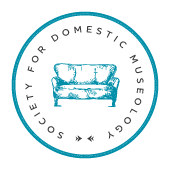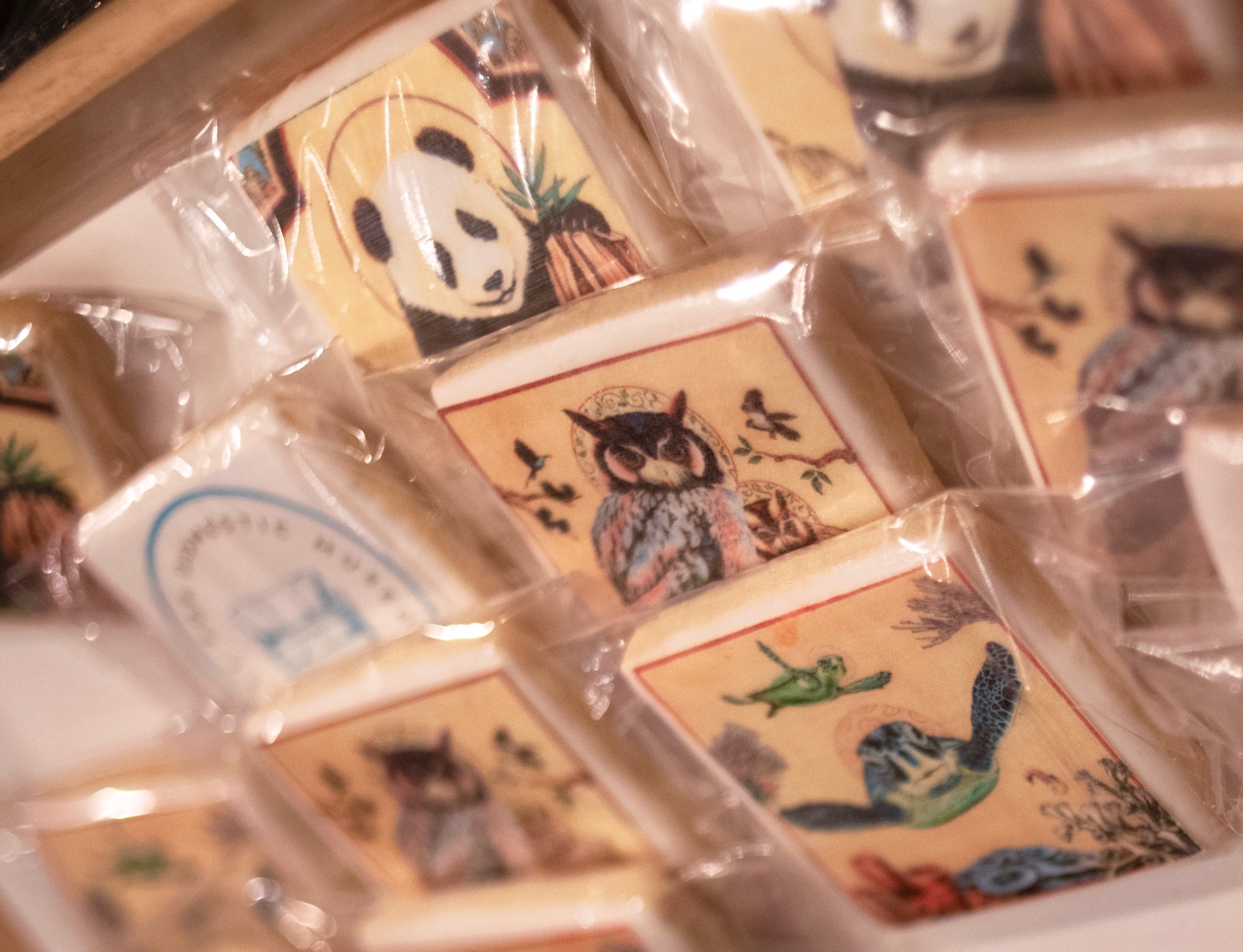After more than a year-long hiatus, the Society for Domestic Museology returned in January, with Salon Icon — a solo pop-up exhibition from artist Peter Gerakaris. Joined by special guest collaborator and composer Trevor Gureckis, the exhibit title references Peter’s Icon Series — an ongoing body of paintings created on panel with gold leaf inspired by the Cretan-Venetian School of Iconography. The event was a visual, auditory, and culinary trip to Byzantium—and an ideal opening to a new chapter for the Society and our mission to create community around arts and ideas.
Like so many of our events in the past couple of years, the collaboration with Peter grew out of a friendship that began at a previous SfDM opening in 2017. Our conversation about his painting, as well as his interest in food and gardening, led to a visit to his Red Hook studio, where I was able to glimpse the depth and breadth of his work.
A self-described “free-range child” of artist parents, Peter grew up in the Edenic environs of rural New Hampshire, where his early artistic education came from exploring the natural world and playing drawing games with his father and mother. He went on to major in fine arts at Cornell, which included studies in painting in Rome, and eventually earned his MFA at Hunter College.
Peter’s work ranges in size, from large-scale installations like the one he did for the Cornell Tech campus on Roosevelt Island, in 2015, and his immersive mural (in-progress) for PS101 in Brooklyn, to tiny, intricate pop-up books and origami sculptures. His paintings are explosively colorful, at times kaleidoscopic, with precise brushwork that holds the line between structure and chaos. And he often works in series, taking an idea and working through several iterations that are dense with detail and symbolism.
For his Domestic Museology exhibition, Peter drew from a recent series of neo-Byzantine icon paintings that he traces back to his time in Rome, where he learned traditional icon painting technique, including the delicate process of gold leaf application, and connected more deeply with his Cretan-Greek heritage. One of his formative works from that time was a traditional Madonna and Child icon that he gave to his Yia Yia. (She later had it blessed by her Greek Orthodox priest and kept it with her for the rest of her life.)
After a more recent trip to Italy renewed his fascination with icon painting, Peter began to experiment with the technique, this time in a non-religious context. Given his strong bond with the natural world, he appropriately chose to paint icons that venerate endangered or threatened animal and plant species: the spotted owl, the loggerhead turtle, various corals, the yellow lady’s slipper orchid, pollinators, Chinese spoonbills, and the giant panda (happily removed from the endangered list in 2016).
Panda Icon Triptych, 36 in. x 23.25 in., Gouache & gold leaf on panel. 2018. Commission for William Lim, Living Collection (Hong Kong, China)
The centerpiece of Peter’s installation was the Panda Icon Triptych, which was recently completed for a prominent collector in Hong Kong and unofficially unveiled at our event just days before it was unveiled for its patron. Sitting atop the black Baldwin upright in our living room, the gilt-haloed panda gazed beatifically from the center panel of the neo-gothic framed triptych. The pastoral backdrop evoked both the landscapes of southern China and the symbolism of the Icon tradition, setting up a conversation between East and West. Also featured in the triptych are endangered Chinese spoonbills, pink dolphins, a rare magnolia, and a Hong Kong skyscraper—the H Queens building designed by the collector, architect William Lim—each element part of a shared vocabulary in the collaboration between artist and collector.
A similar visual language appears in the lady’s slipper painting, commissioned by a new private collector who brought it to this pop-up exhibition as a kind of inter-living room loan. Before starting on this work, Peter and the collector discussed what would make a meaningful personal icon. Lady’s slippers are part of the New Hampshire landscape where they both grew up—and the yellow variety is endangered. Like the Panda triptych, the background is a combination of the traditional rocky outcroppings of the Byzantine tradition, combined with the tall conifers and granite mountains that occupied the surroundings of their shared childhood. Also present is the rusty patched bumblebee, a recurring figure in Peter’s work representing his interest in pollinators and their important role in the web of life.
Orchid Icon, 13.5 in. x 11 in., Gouache & gold leaf on shaped panel w/ frame. 2018. Private Commission & Collection (Brooklyn, New York)
Spotted Owl I was the progenitor of the series and was the first of Peter’s icons that I saw on my studio visit last year. He painted a series of owls that were included in “Transplants: Greek Diaspora Artists,” a group exhibition at John Jay College’s Anya and Andrew Shiva Gallery in 2018. In this painting, a pair of spotted owls perched atop branches of a Douglas Fir lean toward one another echoing a Madonna and Child. Behind them soars a falcon in hidden reference to the artist’s family name: Gerakaris means “the falconer” in Greek.
Spotted Owl Icon I, 16 in. x 16 in., Gouache & gold leaf on panel. 2017. (As exhibited at the National Museum of Wildlife Art)
A pendant to the Spotted Owl Icon is the White-Faced Owl Icon, painted as a special commission for a collector in Johannesburg South Africa (which means it wasn’t technically part of our Salon Icon series, but is another example of these commissioned paintings function as shared language between artist and patron, infused with personal meaning). This threatened species of owl is indigenous to Kruger National Park where the collector and his family spend time, as are the other fauna featured in the painting; the Amur Falcon, Sunbird and South African Grasshopper. The halos are festooned with stylized grape leaves, a nod to the collector’s family vineyard. Situating these South African creatures in a decidedly Greco-Italian context of Byzantine icon painting speaks to contemporary issues of migration, a theme central to the entire icon series. A lover of travel, Gerakaris had the opportunity to travel to South Africa last fall to deliver the painting in person.
White-Faced Owl Icon, 16 in. x 16 in., Gouache & gold leaf on panel. 2018. Private Commission & Collection (Johannesburg, South Africa)
Likewise, the Turtle Icon, was inspired by another of Gerakaris’s travels: to St. Lucia and Grand Cayman, where scuba diving gave him an intimate look at majestic underwater sea creatures and the fragile ecosystem of the endangered coral reef. The painting includes several species that are under direct threat from climate change and water pollution such as, plate coral, tube sponges, gorgonian and elkhorn coral. The highly stylized manner in which these elements are painted (indeed thoughout the series) is another nod to the Cretan-Byzantine tradition where a stylized abstraction was valued as a way to express humility. It was thought that only God could achieve perfection in reality and the role of the icon painter was to create luminous window to mediate between heaven and earth.
Turtle Icon, 16 in. x 16 in., Gouache & gold leaf on panel. 2018
To complement the installation, composer Trevor Gureckis created a gorgeous 30-minute sound piece based on a traditional Medieval Byzantine Chant dedicated to Virgin Mary, "Δεύτε λαοί" (“Come Ye, Peoples”), performed by the Greek Byzantine Choir. Trevor slowed the choral track by a factor of 30 and added layers of harmony, ambient sound -- including sampled Panda noises! -- and strings to create an aural pendant to Peter’s paintings. Haunting and reverent, the sophisticated progression evolved from darker, brooding themes into more uplifting and airy tonalities with an unexpected piano crescendo, transforming our space from a living room into a secular chapel. Moments before guests began to arrive (with remarkable and unusual punctuality), we paused in our last-minute preparations to take in the wonderful symphony of sight and sound and smells wafting from the kitchen.
With nearly 40 attendees that evening, most of whom were new to SfDM, the event was a warm welcome back to a favorite ritual: inviting a mix of friends and not-yet-friends into our living room to talk about art. To complement the paintings and music, we served our own version of a neo-Byzantine feast, including handmade spanakopita, keftides (meatballs), souvlaki, phyllo-wrapped feta, fresh made pita and mini horiatiki salad in cucumber cups (because who doesn’t love a cucumber cup!). Frankly we have no idea if our menu was historically accurate, but it was delicious all the way down to the semolina custard and Byzantine spice cake, served with the Greek spirits Mastika and Tsipporos.
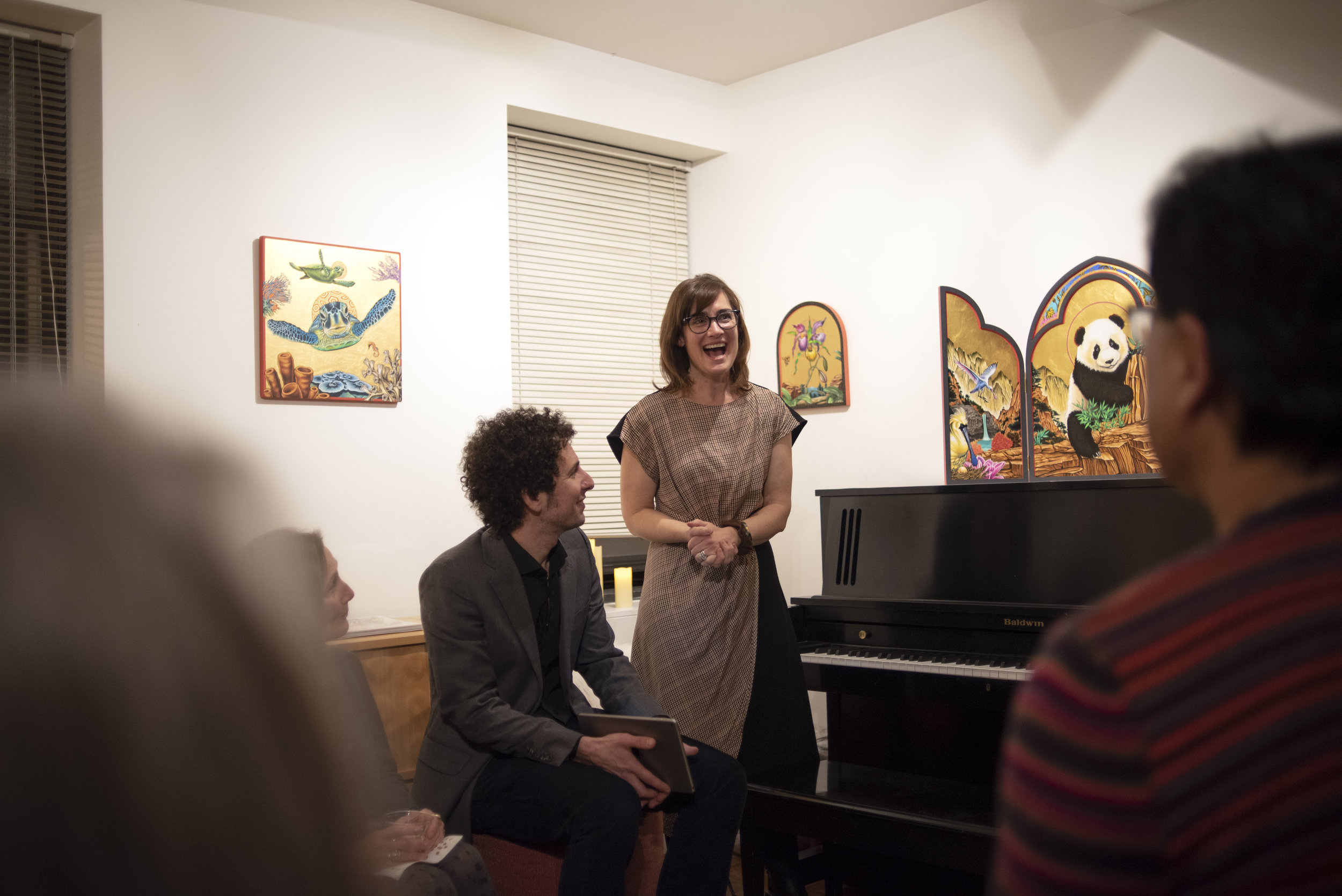

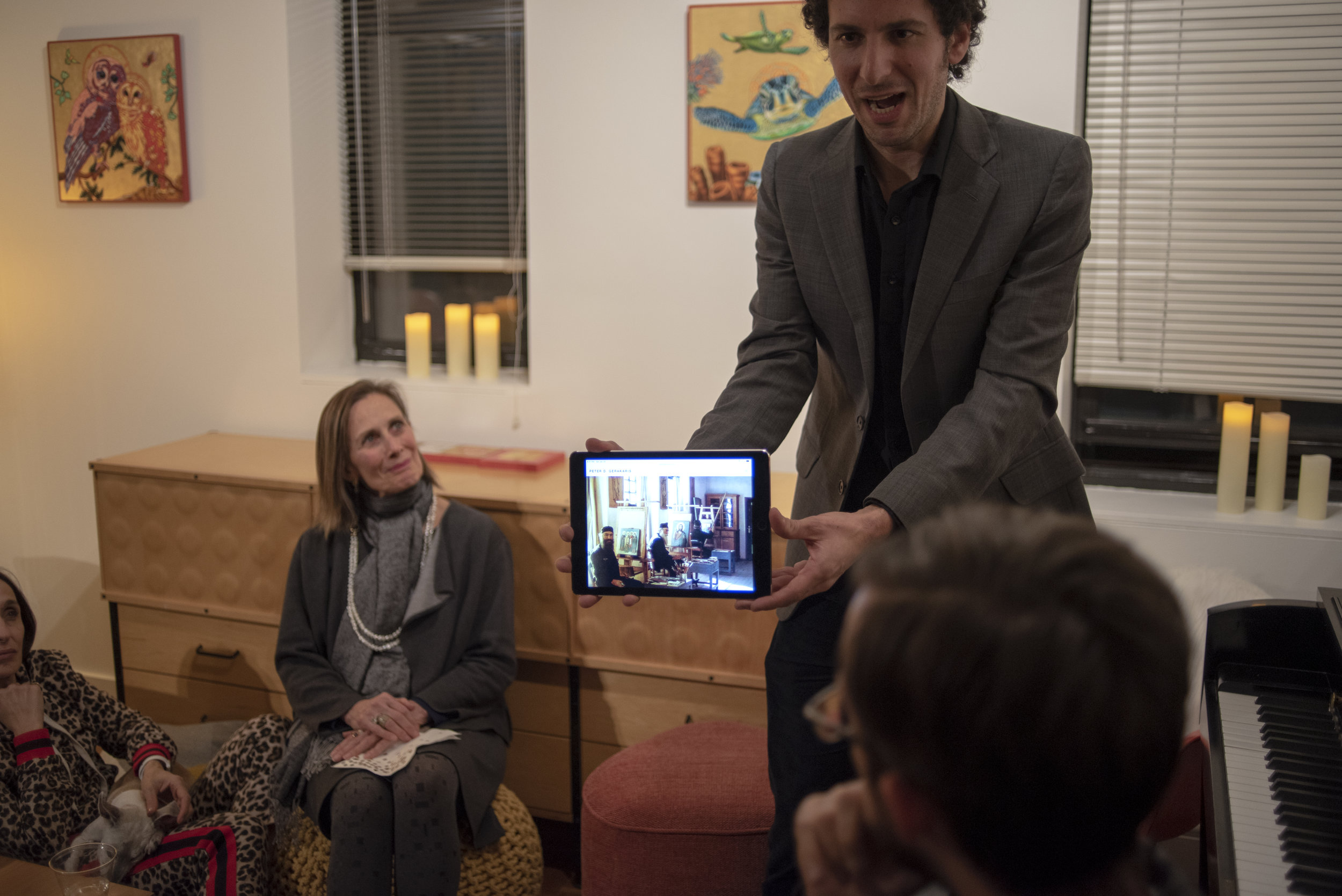

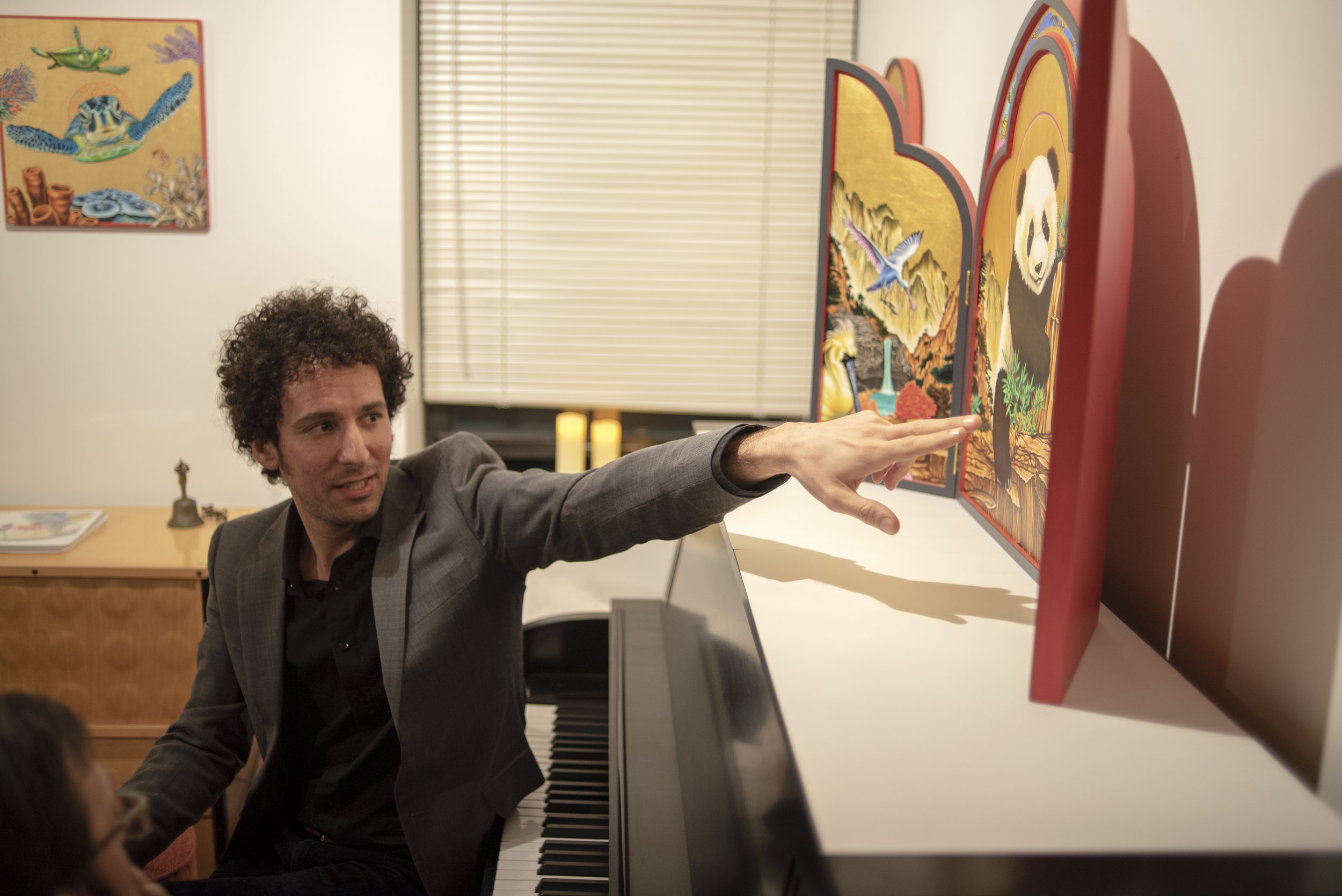
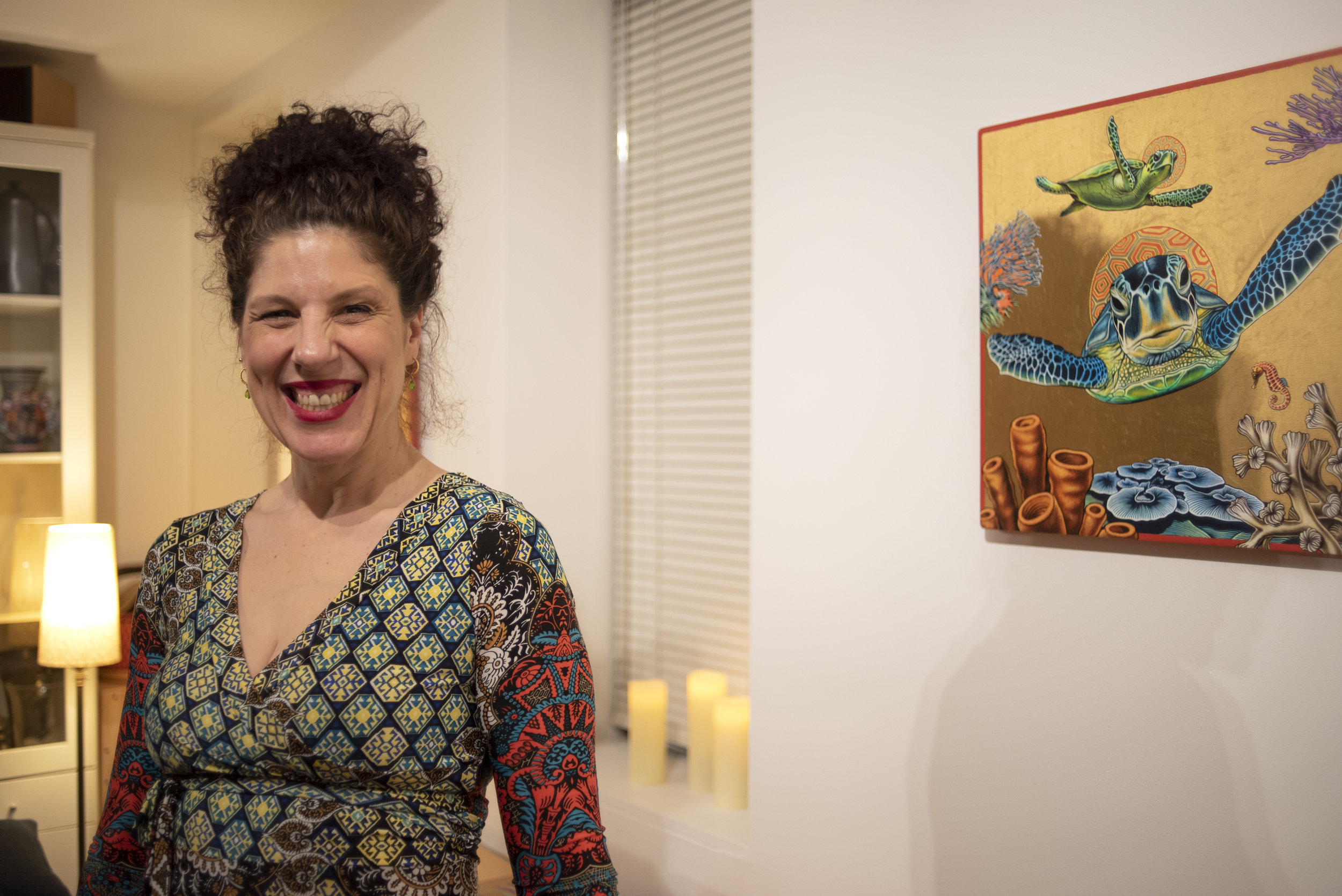
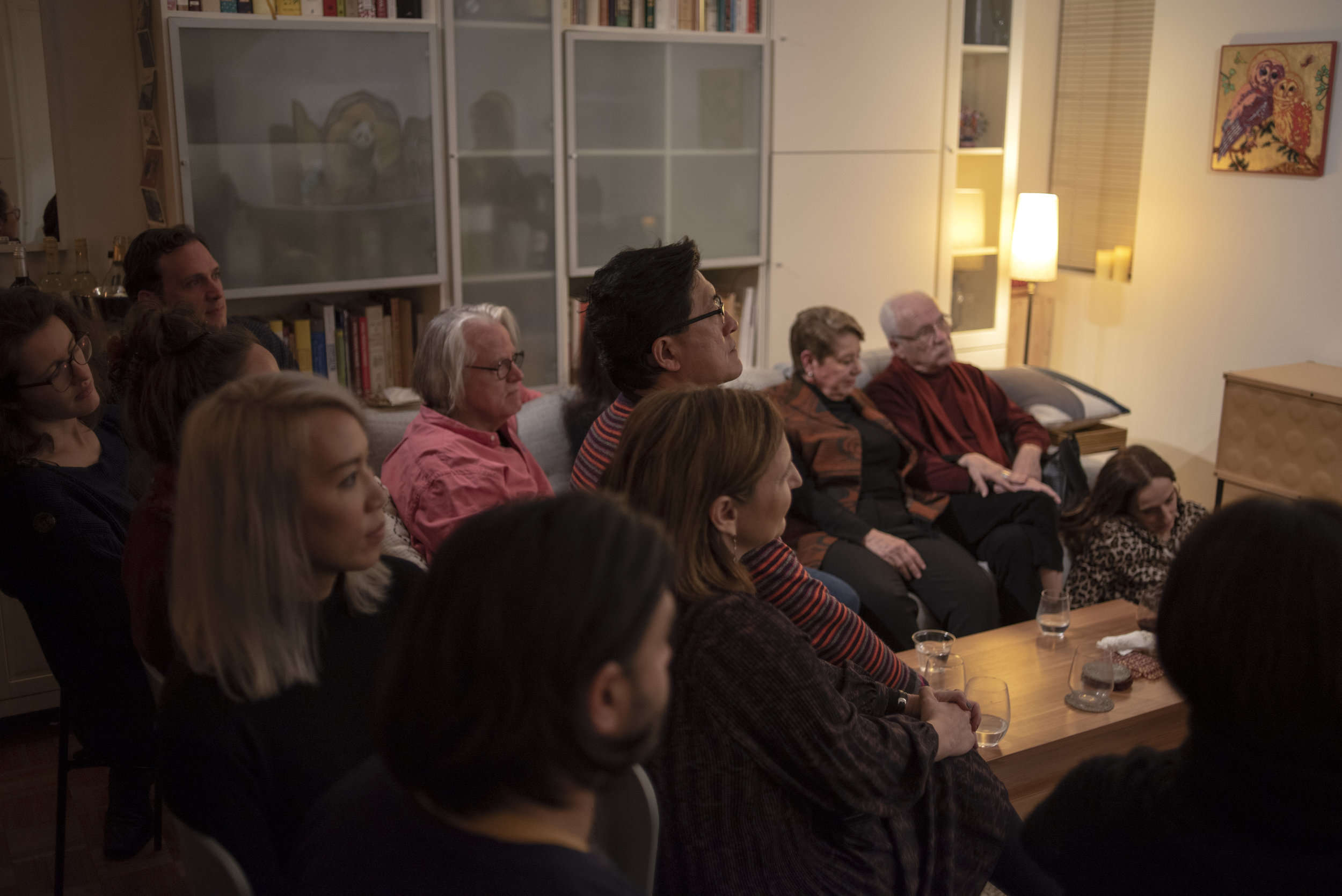
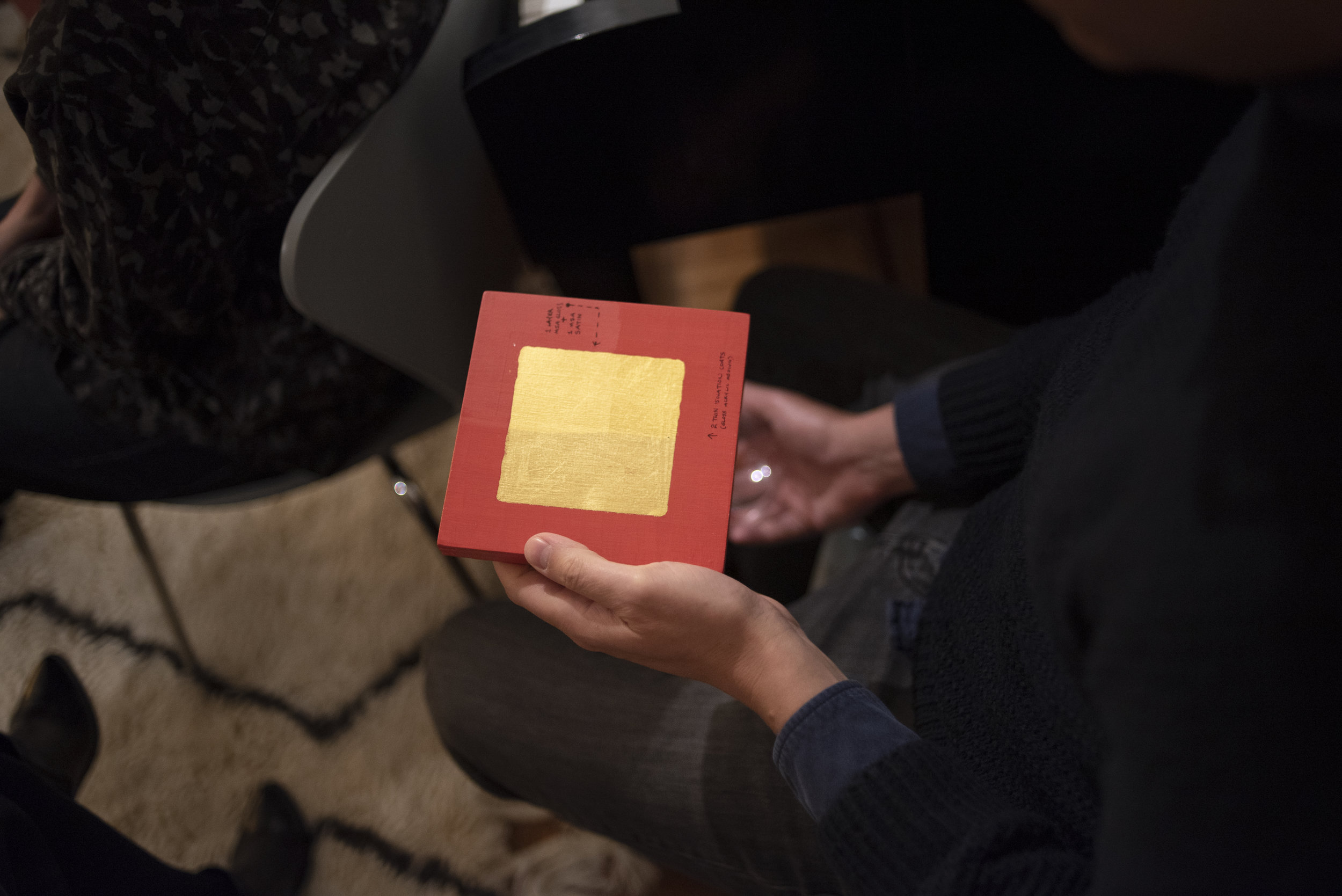
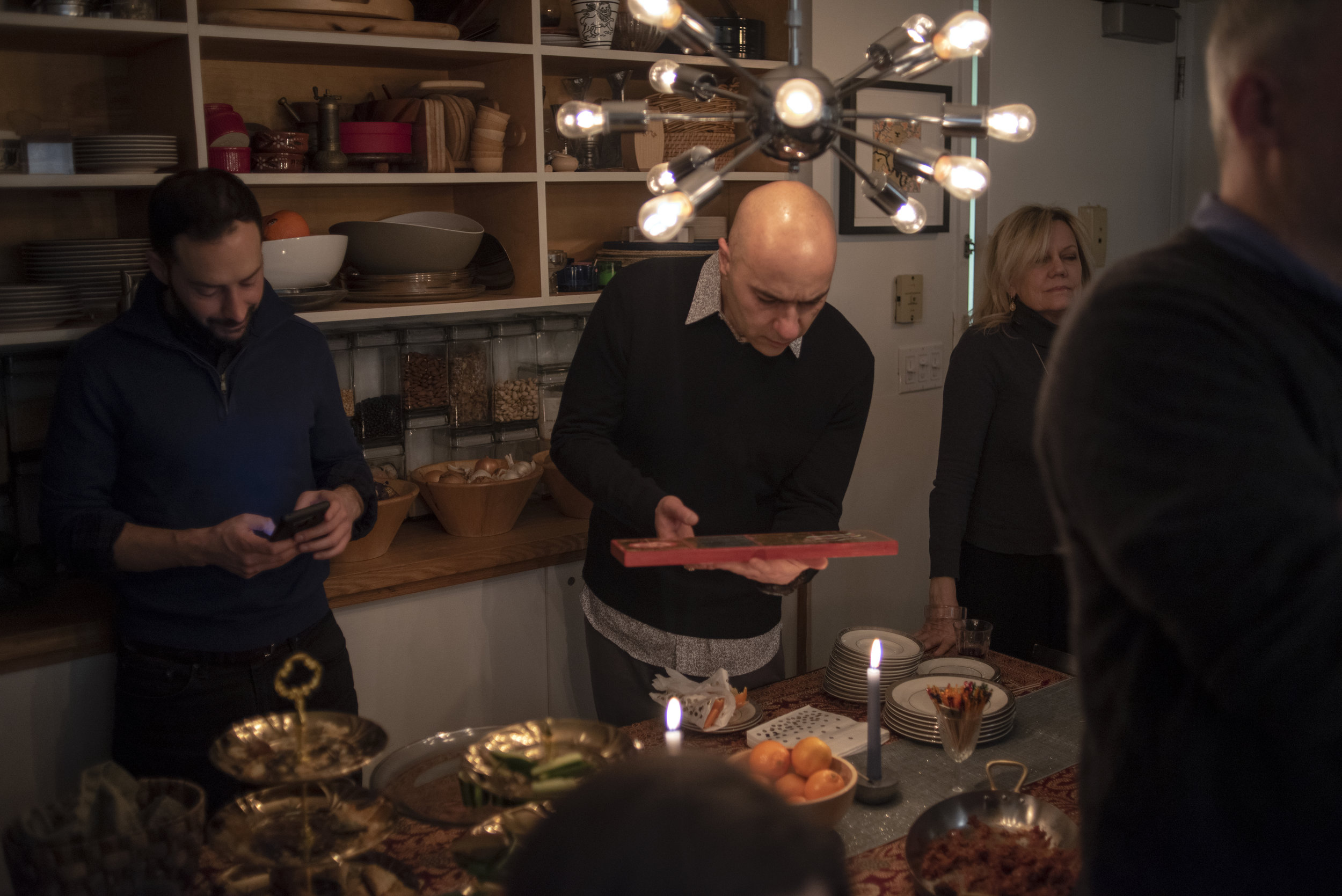
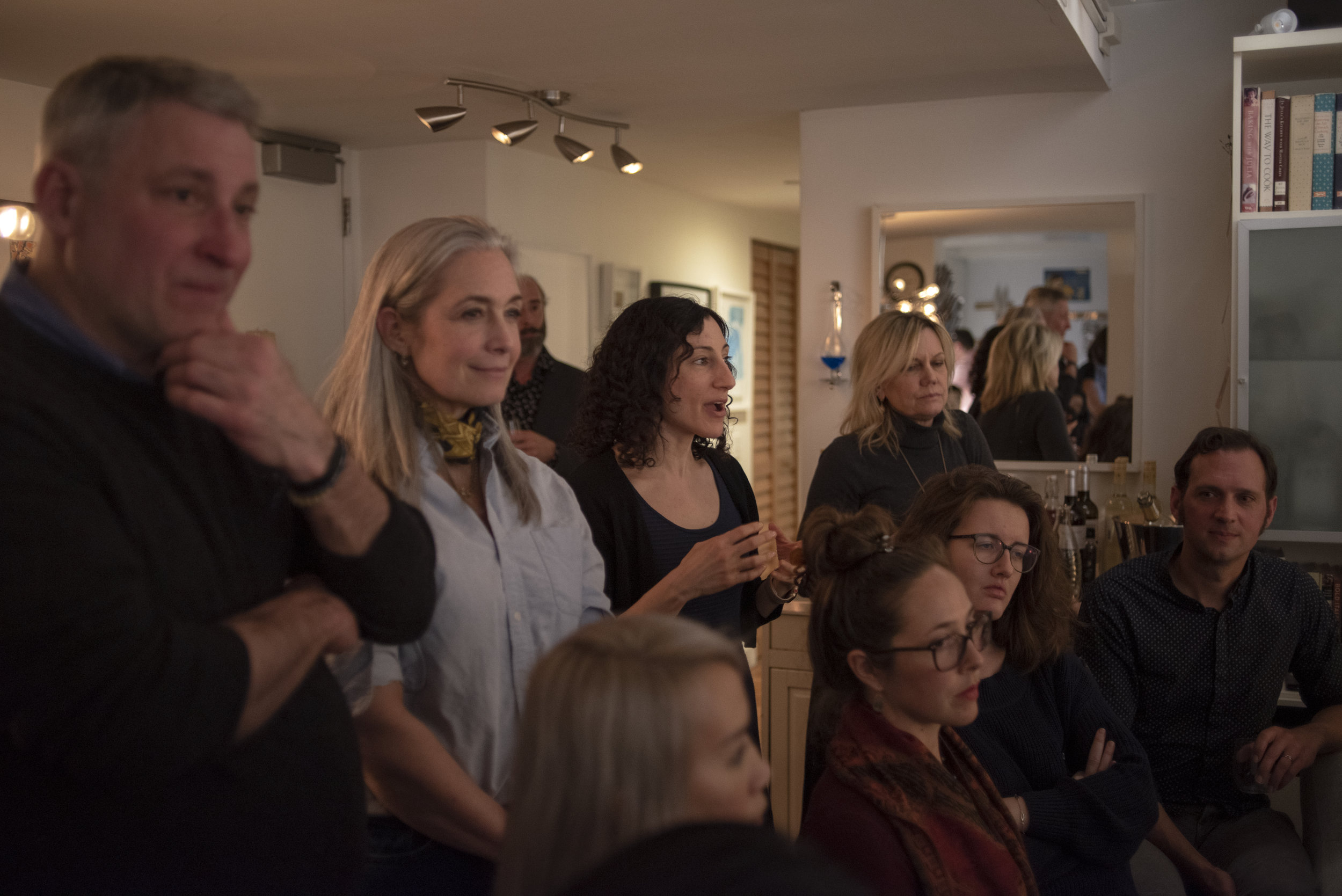
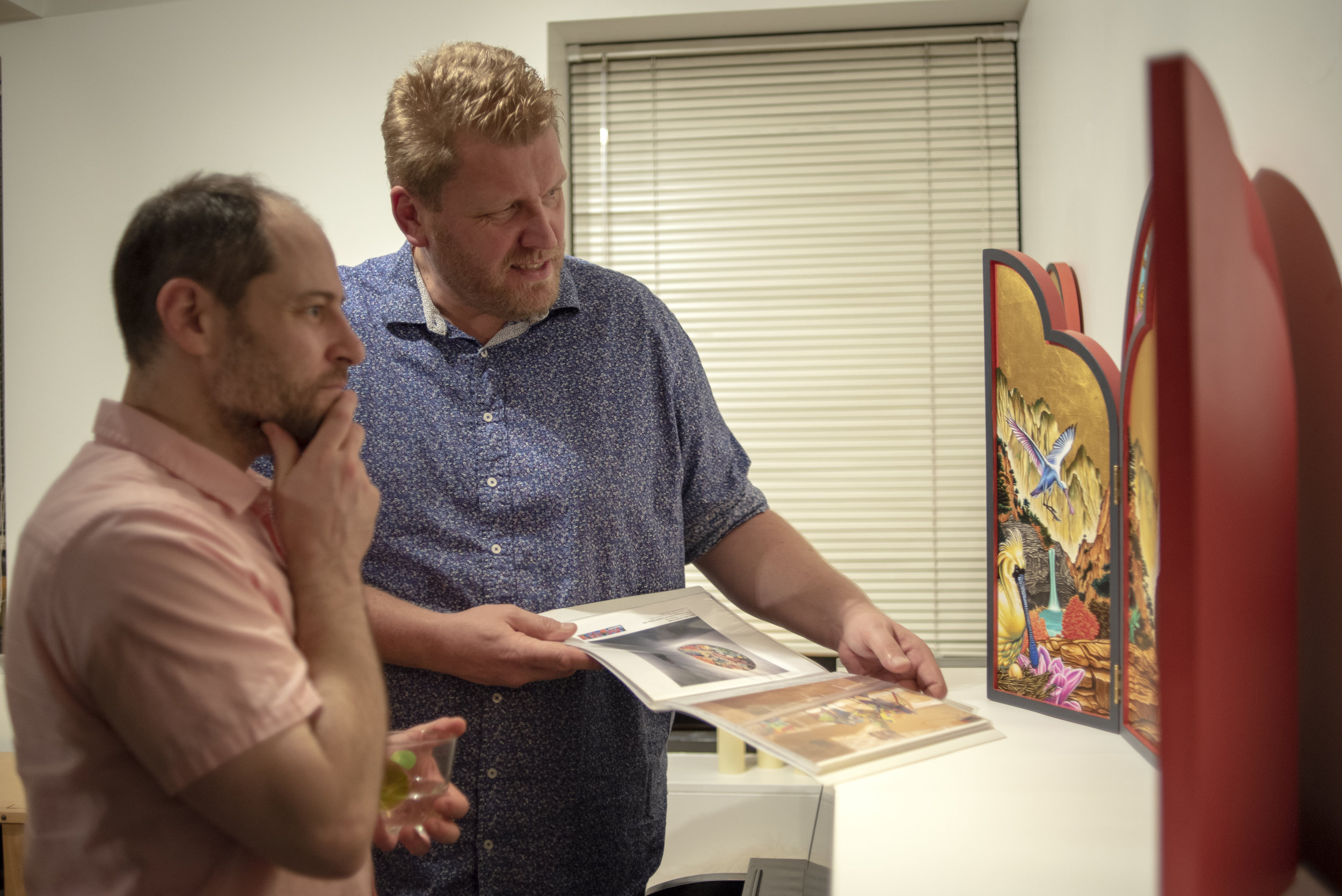
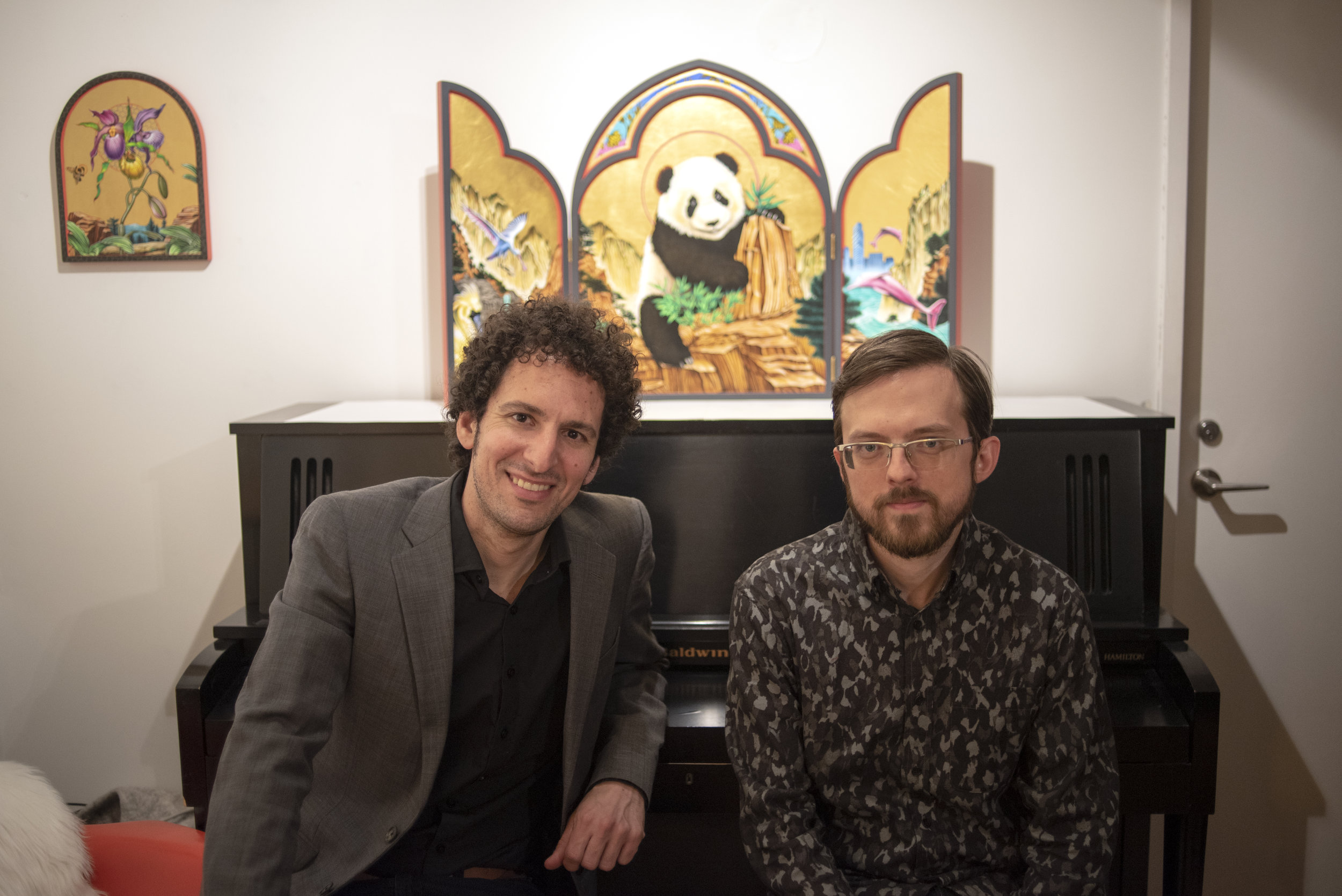
Once everyone was settled in with food and drink, we packed ourselves into the living room to hear Peter’s presentation of his work, focusing on his icon process and its connection to his own Cretan heritage. He showed samples that he uses to determine the right kind of gold leaf for each painting and walked us through the precise application process. While he honors what he feels is a sacred process (still practiced by a handful of credentialed Iconographers today!), he uses it to create his own hagiographic iconography of animalia and the natural world.
Trevor described a similar process in his sound piece—a kind of call and response between the visual and sound work, the historic points of reference and the contemporary moment. Like the paintings, the music creates a bridge between the 11th century and the present, grounded in Byzantine chant but punctuated with sounds which would have been unknown to the Medieval ear.
As we wound down the evening over dessert, we gave each guest a memento to take home, gorgeous icon cookies baked by our dear friend and collaborator, Clarelicious! I am still basking in the spirit of collaboration and generosity that made the evening possible. The time and effort that Peter and Trevor put into this collaboration, the openness each guest brought with them, the gratitude everyone expressed for the opportunity to meet, to see, hear, and talk about art—these are the very reasons why I created The Society for Domestic Museology.
